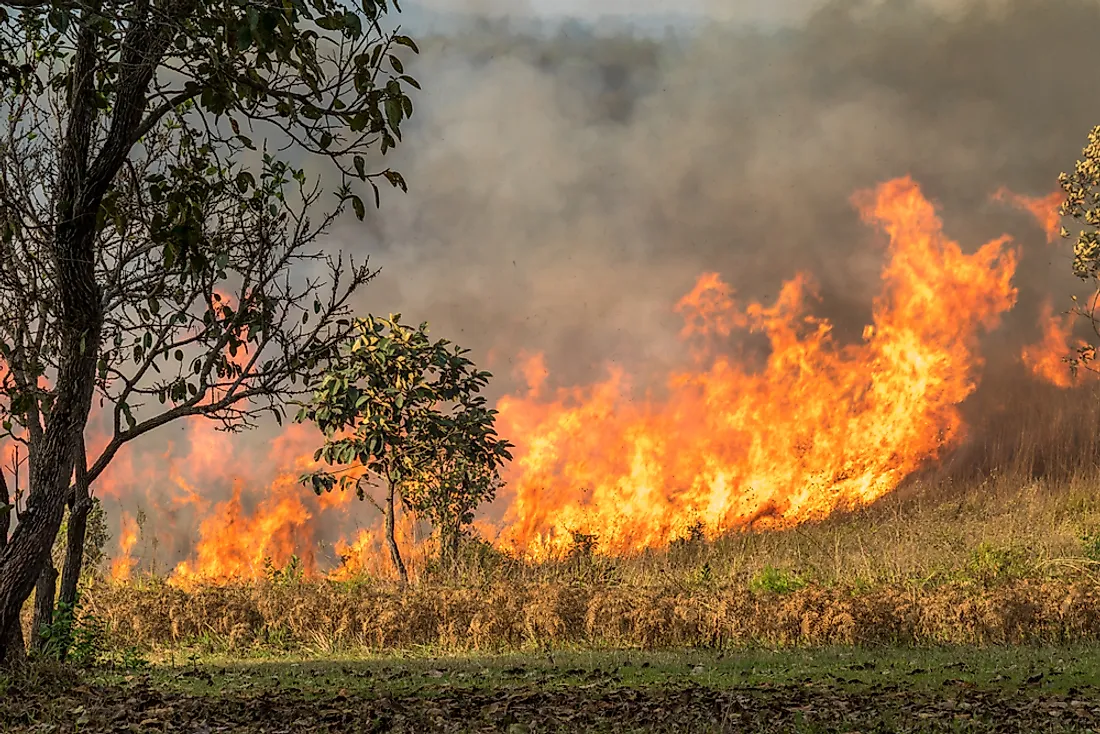How Does A Wildfire Spread?

A wildfire in an uncontrollable fire in an area with vegetative matter that is combustible (dry). Wildfires may occur in areas with forest cover, brushland, or grassland. The various types of wildfires can be classified depending on the characteristic of the fire and the vegetative matter that fuels, for example, veld fires, hill fires, bush fires, forest fires, brush fires, and grass fires.
Causes of Wildfires
Common causes of wildfire can be either natural including dry climate resulting in intense heat and dry combustible vegetative matter, lighting, and volcanic eruptions or due to human activity such as arson, careless disposal of cigarettes, sparks from ignition of equipment, and agricultural practices such as slash and burn. In countries like China, Canada, and the United States, wildfires are mainly caused by lightning and at times human activity. Human activity as a cause of fires is most common in Mexico, Fiji, and in many parts of Africa and South America.
How Do Wildfires Spread?
A fire starts when a source of ignition comes into contact with combustible material in the presence of oxygen. When a wildfire starts, the surrounding air and combustible material is heated through thermal radiation and convection leading to the evaporation of moisture at 212°F in the surrounding vegetation. At 450°F, flammable gases are released by the wood through a process called pyrolysis. At 720°F, the wood begins to smolder and after sufficient heating, ignites at 1,000°F. Typically, heat transfer from a wildfire can heat surrounding air to 1,470°F, drying all flammable matter in the immediate vicinity and encouraging the fire to spread much faster.
Factors Influencing Wildfire Spreading
The type of flammable material present often determines the rate of spread of a wildfire. Other factors that influence the spread of wildfires include weather conditions, the density of the combustible material, humidity, topography, and the moisture content in the fuel.
Weather and Topography
Windy and dry weather conditions create optimal conditions for the spread of wildfire, strong winds can help increase the intensity of fire by providing the much need oxygen necessary for combustion and spreading the wildfire. The topography of an area plays a huge role in determining the potential rate at which a fire can spread. For example, in mountainous or hilly areas wildfires tend to spread more quickly uphill compared to downhill.
Moisture Content, Humidity, and Vegetation Density
The vegetative matter with high levels of moisture content can lead to difficulty in ignition and spread of the wildfire. Vegetation with lower amounts of moisture content, such as grass, tend to encourage higher rates of wildfire propagation compared to succulent vegetation. Wildfire is also less likely to spread in areas with dense forests due to canopies and shade that provides lower temperatures and higher humidity. The density of vegetation cover can, however, encourage the spread of wildfire, for example, wildfires in grasslands can spread at about 14 miles per hour while dense forests can experience wildfire spread of almost 6.7 miles per hour.
Effects of Wildfires
Wildfires are often very dangerous and can cause loss of property and loss of human life. Some of the largest wildfires in the world have caused thousands of deaths as well as burned private property and natural cover. Studies of the effects of wildfire, however, reveal that their occurrence can be beneficial to some of the ecosystems in which they occur. Wildfires can help breathe new life into an ecosystem cleaning the forest floor thus allowing new vegetation to germinate. Wildfires also help in the regeneration of plants such as manzanita and oak whose seeds rely on intense heat to enable their germination.
Controlling Wildfires
Wildfires can be controlled using fire department equipment, earth moving machines, portable pumps, water trucks, and aircraft that can be used to spray water and fire retardant over affected areas. Specially trained fire-force personnel are also used to remove vegetation at the fire front and to beat out flames.











